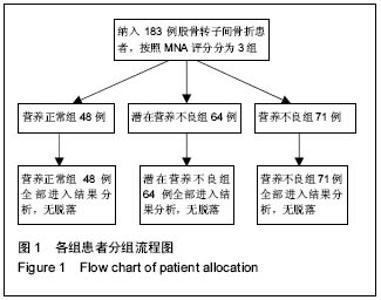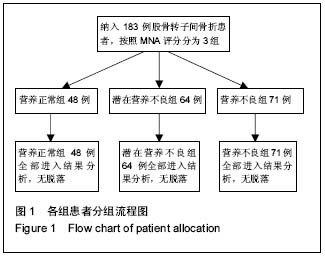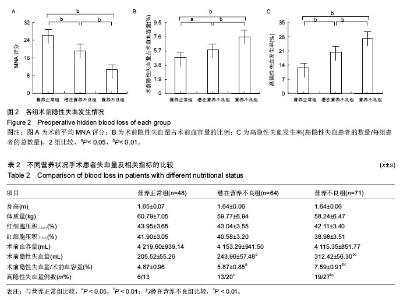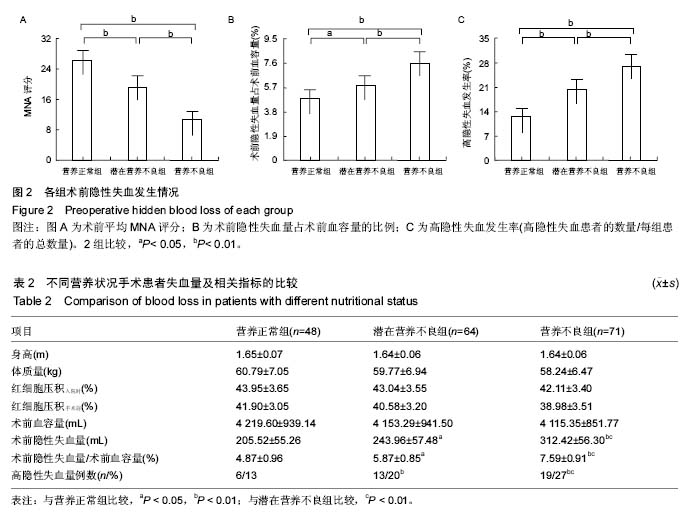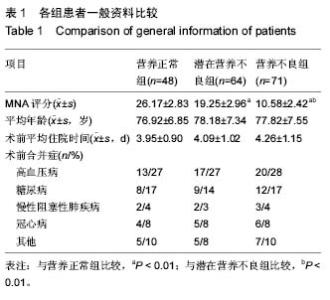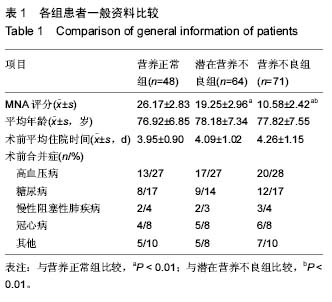Chinese Journal of Tissue Engineering Research ›› 2016, Vol. 20 ›› Issue (37): 5489-5459.doi: 10.3969/j.issn.2095-4344.2016.37.003
Previous Articles Next Articles
Correlation between preoperative hidden blood loss and nutritional status in elderly patients with intertrochanteric fracture
Liu Guo-yin1, Zhang Yong1, Bao Lei2, Wang Jin1, Xu Yuan-sheng1, Wang Meng-ru3, Jia Xiao-bao1, Chen Jian-min1
- 1Department of Orthopedics, 2Operation Room, Nanjing 81st Hospital of PLA, Nanjing 210002, Jiangsu Province, China; 3Jiangsu University, Zhenjiang 212013, Jiangsu Province, China
-
Online:2016-09-09Published:2016-09-09 -
Contact:Chen Jian-min, Department of Orthopedics, Nanjing 81st Hospital of PLA, Nanjing 210002, Jiangsu Province, China -
About author:Liu Guo-yin, Master, Physician, Department of Orthopedics, Nanjing 81st Hospital of PLA, Nanjing 210002, Jiangsu Province, China -
Supported by:the Science and Technology Project of Nanjing City, No. 201303039; the Science and Technology Innovation Project of Nanjing Military Region, No. MS055
CLC Number:
Cite this article
Liu Guo-yin, Zhang Yong, Bao Lei, Wang Jin, Xu Yuan-sheng, Wang Meng-ru, Jia Xiao-bao, Chen Jian-min. Correlation between preoperative hidden blood loss and nutritional status in elderly patients with intertrochanteric fracture[J]. Chinese Journal of Tissue Engineering Research, 2016, 20(37): 5489-5459.
share this article
| [1] Brauer CA, Coca-Perraillon M, Cutler DM, et al. Incidence and mortality of hip fractures in the United States. JAMA. 2009;302:1573-1579. [2] Johnell O, Kanis JA. An estimate of the worldwide prevalence, mortality and disability associated with hip fracture. Osteoporos Int. 2004;15:897-902. [3] Boddaert J, Raux M, Khiami F, et al. Perioperative management of elderly patients with hip fracture. Anesthesiology. 2014;121:1336-1341. [4] Boddaert J, Cohen-Bittan J, Khiami F, et al. Postoperative admission to a dedicated geriatric unit decreases mortality in elderly patients with hip fracture. PLoS One. 2014;9:e83795. [5] Murphy MC, Brooks CN, New SA, et al. The use of the Mini-Nutritional Assessment (MNA) tool in elderly orthopaedic patients. Eur J Clin Nutr. 2000;54:555-562. [6] Guigoz Y, Vellas B, Garry PJ. Assessing the nutritional status of the elderly: The Mini Nutritional Assessment as part of the geriatric evaluation. Nutr Rev. 1996;54: S59-65. [7] Dwyer JT, Gallo JJ, Reichel W. Assessing nutritional status in elderly patients. Am Fam Physician. 1993; 47:613-620. [8] Scholl R. Nutrition and aging: assessing the nutritional status of the elderly patient. J Kans Med Soc. 1982;83: 368-370. [9] Fiatarone Singh MA. Exercise, nutrition and managing hip fracture in older persons. Curr Opin Clin Nutr Metab Care. 2014;17:12-24. [10] Foss NB, Kehlet H. Hidden blood loss after surgery for hip fracture. J Bone Joint Surg Br. 2006;88: 1053-1059. [11] Smith GH, Tsang J, Molyneux SG, et al. The hidden blood loss after hip fracture. Injury. 2011;42:133-135. [12] Yasunaga H, Tsuchiya K, Matsuyama Y, et al. High-volume surgeons in regard to reductions in operating time, blood loss, and postoperative complications for total hip arthroplasty. J Orthop Sci. 2009;14:3-9. [13] Li J, Cheng L, Jing J. The Asia proximal femoral nail antirotation versus the standard proximal femoral antirotation nail for unstable intertrochanteric fractures in elderly Chinese patients. Orthop Traumatol Surg Res. 2015;101(2):143-146. [14] He W, Zhang W. The curative effect comparison between prolonged third generation of gamma nail and prolonged dynamic hip screw internal fixation in treating femoral intertrochanteric fracture and the effect on infection. Cell Biochem Biophys. 2015;71: 695-699. [15] Inal S, Taspinar F, Gulbandilar E, et al. Comparison of the biomechanical effects of pertrochanteric fixator and dynamic hip screw on an intertrochanteric femoral fracture using the finite element method. Int J Med Robot. 2015;11:95-103. [16] Xu Z, Zhang M, Yin J, et al. Redisplacement after reduction with intramedullary nails in surgery of intertrochanteric fracture: cause analysis and preventive measures. Arch Orthop Trauma Surg. 2015; 135(6):751-758. [17] Tawari AA, Kempegowda H, Suk M, et al. What makes an intertrochanteric fracture unstable in 2015? Does the lateral wall play a role in the decision matrix? J Orthop Trauma. 2015;29 Suppl 4:S4-9. [18] Martin-Martin LM, Arroyo-Morales M, Sanchez-Cruz JJ, et al. Factors Influencing Performance-Oriented Mobility After Hip Fracture. J Aging Health. 2015. [19] Watt J, Cox L, Crilly RG. Distribution of vertebral fractures varies among patients according to hip fracture type. Osteoporos Int. 2015;26:885-890. [20] Neuman MD, Rosenbaum PR, Ludwig JM, et al. Anesthesia technique, mortality, and length of stay after hip fracture surgery. JAMA. 2014;311:2508-2517. [21] Patorno E, Neuman MD, Schneeweiss S, et al. Comparative safety of anesthetic type for hip fracture surgery in adults: retrospective cohort study. BMJ. 2014;348:g4022. [22] Karampampa K, Ahlbom A, Michaelsson K, et al. Declining incidence trends for hip fractures have not been accompanied by improvements in lifetime risk or post-fracture survival - A nationwide study of the Swedish population 60years and older. Bone. 2015; 78:55-61. [23] Chehade MJ, Carbone T, Awward D, et al. The influence of fracture stability on early patient mortality and reoperation after pertrochanteric and intertrochanteric hip fractures. J Orthop Trauma. 2015;29(12):538-543. [24] Joshi D, Dhamangaonkar AC, Ramawat S, et al. Predictors of iatrogenic lateral wall fractures while treating intertrochanteric fracture femur with the dynamic hip screw system in Indian patients. Eur J Orthop Surg Traumatol. 2015;25:677-682. [25] Sadic S, Custovic S, Jasarevic M, et al. Proximal femoral nail antirotation in treatment of fractures of proximal femur. Med Arch. 2014;68:173-177. [26] Omsland TK, Emaus N, Tell GS, et al. Mortality following the first hip fracture in Norwegian women and men (1999-2008). A NOREPOS study. Bone. 2014;63: 81-86. [27] Krogseth M, Wyller TB, Engedal K, et al. Delirium is a risk factor for institutionalization and functional decline in older hip fracture patients. J Psychosom Res. 2014; 76:68-74. [28] Mendez-Gil A, Fernandez-Valencia Laborde JA, Estrada-Masllorens JM, et al. [Minimally invasive dynamic hip screw technique: Shorter surgical time with similar post-surgical results compared to conventional DHS technique. A retrospective cohort study]. Rev Esp Cir Ortop Traumatol. 2014;58: 351-356. [29] Schwartsmann CR, Jacobus LS, Spinelli Lde F, et al. Dynamic hip screw for the treatment of femoral neck fractures: a prospective study with 96 patients. ISRN Orthop. 2014;2014:257871. [30] Kazemian GH, Manafi AR, Najafi F, et al. Treatment of intertrochanteric fractures in elderly highrisk patients: dynamic hip screw vs. external fixation. Injury. 2014;45: 568-572. [31] Ha YC, Park YG, Nam KW, et al. Trend in hip fracture incidence and mortality in Korea: a prospective cohort study from 2002 to 2011. J Korean Med Sci. 2015;30: 483-488. [32] Kronborg L, Bandholm T, Kehlet H, et al. Municipality-based physical rehabilitation after acute hip fracture surgery in Denmark. Dan Med J. 2015; 62(4): A5023. [33] Goisser S, Schrader E, Singler K, et al. Malnutrition According to Mini Nutritional Assessment Is Associated With Severe Functional Impairment in Geriatric Patients Before and up to 6 Months After Hip Fracture. J Am Med Dir Assoc. 2015;16(8):661-667. [34] Barne M. Oral nutritional support in hip fracture patients. Br J Community Nurs. 2014;Suppl:S6, S8. [35] Bell JJ, Bauer JD, Capra S, et al. Concurrent and predictive evaluation of malnutrition diagnostic measures in hip fracture inpatients: a diagnostic accuracy study. Eur J Clin Nutr. 2014;68(3):358-362. [36] Drevet S, Bioteau C, Maziere S, et al. Prevalence of protein-energy malnutrition in hospital patients over 75 years of age admitted for hip fracture. Orthop Traumatol Surg Res. 2014;100(6):669-674. [37] Cram P, Lu X, Kaboli PJ, et al. Clinical characteristics and outcomes of Medicare patients undergoing total hip arthroplasty, 1991-2008. JAMA. 2011;305: 1560-1567. [38] Duncan DG, Beck SJ, Hood K, et al. Using dietetic assistants to improve the outcome of hip fracture: a randomised controlled trial of nutritional support in an acute trauma ward. Age Ageing. 2006;35:148-153. [39] Vermesan D, Trocan I, Prejbeanu R, et al. Reduced operating time but not blood loss with cruciate retaining total knee arthroplasty. J Clin Med Res. 2015;7: 171-175. [40] Gill R. Practical management of major blood loss. Anaesthesia. 2015;70 Suppl 1:54-57, e19-20. [41] Yang Y, Lv YM, Ding PJ, et al. The reduction in blood loss with intra-articular injection of tranexamic acid in unilateral total knee arthroplasty without operative drains: a randomized controlled trial. Eur J Orthop Surg Traumatol. 2015;25:135-139. |
| [1] | Zhang Tongtong, Wang Zhonghua, Wen Jie, Song Yuxin, Liu Lin. Application of three-dimensional printing model in surgical resection and reconstruction of cervical tumor [J]. Chinese Journal of Tissue Engineering Research, 2021, 25(9): 1335-1339. |
| [2] | Zeng Yanhua, Hao Yanlei. In vitro culture and purification of Schwann cells: a systematic review [J]. Chinese Journal of Tissue Engineering Research, 2021, 25(7): 1135-1141. |
| [3] | Xu Dongzi, Zhang Ting, Ouyang Zhaolian. The global competitive situation of cardiac tissue engineering based on patent analysis [J]. Chinese Journal of Tissue Engineering Research, 2021, 25(5): 807-812. |
| [4] | Wu Zijian, Hu Zhaoduan, Xie Youqiong, Wang Feng, Li Jia, Li Bocun, Cai Guowei, Peng Rui. Three-dimensional printing technology and bone tissue engineering research: literature metrology and visual analysis of research hotspots [J]. Chinese Journal of Tissue Engineering Research, 2021, 25(4): 564-569. |
| [5] | Chang Wenliao, Zhao Jie, Sun Xiaoliang, Wang Kun, Wu Guofeng, Zhou Jian, Li Shuxiang, Sun Han. Material selection, theoretical design and biomimetic function of artificial periosteum [J]. Chinese Journal of Tissue Engineering Research, 2021, 25(4): 600-606. |
| [6] | Liu Fei, Cui Yutao, Liu He. Advantages and problems of local antibiotic delivery system in the treatment of osteomyelitis [J]. Chinese Journal of Tissue Engineering Research, 2021, 25(4): 614-620. |
| [7] | Li Xiaozhuang, Duan Hao, Wang Weizhou, Tang Zhihong, Wang Yanghao, He Fei. Application of bone tissue engineering materials in the treatment of bone defect diseases in vivo [J]. Chinese Journal of Tissue Engineering Research, 2021, 25(4): 626-631. |
| [8] | Zhang Zhenkun, Li Zhe, Li Ya, Wang Yingying, Wang Yaping, Zhou Xinkui, Ma Shanshan, Guan Fangxia. Application of alginate based hydrogels/dressings in wound healing: sustained, dynamic and sequential release [J]. Chinese Journal of Tissue Engineering Research, 2021, 25(4): 638-643. |
| [9] | Chen Jiana, Qiu Yanling, Nie Minhai, Liu Xuqian. Tissue engineering scaffolds in repairing oral and maxillofacial soft tissue defects [J]. Chinese Journal of Tissue Engineering Research, 2021, 25(4): 644-650. |
| [10] | Xing Hao, Zhang Yonghong, Wang Dong. Advantages and disadvantages of repairing large-segment bone defect [J]. Chinese Journal of Tissue Engineering Research, 2021, 25(3): 426-430. |
| [11] | Chen Siqi, Xian Debin, Xu Rongsheng, Qin Zhongjie, Zhang Lei, Xia Delin. Effects of bone marrow mesenchymal stem cells and human umbilical vein endothelial cells combined with hydroxyapatite-tricalcium phosphate scaffolds on early angiogenesis in skull defect repair in rats [J]. Chinese Journal of Tissue Engineering Research, 2021, 25(22): 3458-3465. |
| [12] | Wang Hao, Chen Mingxue, Li Junkang, Luo Xujiang, Peng Liqing, Li Huo, Huang Bo, Tian Guangzhao, Liu Shuyun, Sui Xiang, Huang Jingxiang, Guo Quanyi, Lu Xiaobo. Decellularized porcine skin matrix for tissue-engineered meniscus scaffold [J]. Chinese Journal of Tissue Engineering Research, 2021, 25(22): 3473-3478. |
| [13] | Mo Jianling, He Shaoru, Feng Bowen, Jian Minqiao, Zhang Xiaohui, Liu Caisheng, Liang Yijing, Liu Yumei, Chen Liang, Zhou Haiyu, Liu Yanhui. Forming prevascularized cell sheets and the expression of angiogenesis-related factors [J]. Chinese Journal of Tissue Engineering Research, 2021, 25(22): 3479-3486. |
| [14] | Liu Chang, Li Datong, Liu Yuan, Kong Lingbo, Guo Rui, Yang Lixue, Hao Dingjun, He Baorong. Poor efficacy after vertebral augmentation surgery of acute symptomatic thoracolumbar osteoporotic compression fracture: relationship with bone cement, bone mineral density, and adjacent fractures [J]. Chinese Journal of Tissue Engineering Research, 2021, 25(22): 3510-3516. |
| [15] | Liu Liyong, Zhou Lei. Research and development status and development trend of hydrogel in tissue engineering based on patent information [J]. Chinese Journal of Tissue Engineering Research, 2021, 25(22): 3527-3533. |
| Viewed | ||||||
|
Full text |
|
|||||
|
Abstract |
|
|||||
